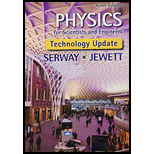
Concept explainers
(a)
The magnitude of the induced current in the wire.
(a)
Answer to Problem 31.20P
The magnitude of the induced current in the wire is
Explanation of Solution
Given info: The radius of the upper circle is
Write the expression for the area of the loop.
Here,
For upper circle.
Substitute
Thus, the area of the upper circle is
For lower circle.
Substitute
Thus, the area of the lower circle is
Write the expression for the magnetic flux through a coil
Here,
Write the expression for the emf of the coil.
Here,
Substitute
For the upper circle.
Substitute
Thus, the emf induced in the upper loop is
For the lower circle.
Substitute
Thus, the emf induced in the upper loop is
Write the expression for the resistance.
Here,
For upper circle.
Substitute
Thus, the resistance in the upper circle is
For lower circle.
Substitute
Thus, the resistance in the lower circle is
Write the expression for the induced current.
Substitute
Conclusion:
Therefore, the magnitude of the induced current in the wire is
(b)
The direction of the induced current in the wire.
(b)
Answer to Problem 31.20P
The current is clockwise in the upper loop and the current is counterclockwise in the lower loop
Explanation of Solution
Given info: The radius of the upper circle is
Write the expression for the induced current in the wire.
Consider negative current as clockwise and positive current as counterclockwise.
From the above expression, the induced current is directly proportional to the induced emf. From part (a), the value of the induced emf for upper loop is negative, so the value of the current is also negative. The negative current shows the current is clockwise in the upper loop. And also from part (a), the value of the induced emf for lower loop is positive, so the value of the current is also positive. The positive current shows the current is counterclockwise in the lower loop. Thus, the current is clockwise in the upper loop and the current is counterclockwise in the lower loop.
Conclusion:
Therefore, the current is clockwise in the upper loop and the current is counterclockwise in the lower loop.
Want to see more full solutions like this?
Chapter 31 Solutions
Bundle: Physics for Scientists and Engineers, Technology Update, 9th Loose-leaf Version + WebAssign Printed Access Card, Multi-Term
- Figure 29-43 Problem 12. ••13 In Fig. 29-44, point P₁ is at distance R = 13.1 cm on the perpendicular bisector of a straight wire of length L = 18.0 cm carrying current i = 58.2 mA. (Note that the wire is not long.) What is the magnitude of the magnetic field at P₁ due to i? P2° R R Larrow_forwardCheckpoint 1 The figure shows the current i in a single-loop circuit with a battery B and a resistance R (and wires of neg- ligible resistance). (a) Should the emf arrow at B be drawn pointing leftward or rightward? At points a, B C R b, and c, rank (b) the magnitude of the current, (c) the electric potential, and (d) the electric potential energy of the charge carriers, greatest first.arrow_forwardPls help ASAParrow_forward
- Pls help asaparrow_forwardPls help asaparrow_forward3. If the force of gravity stopped acting on the planets in our solar system, what would happen? a) They would spiral slowly towards the sun. b) They would continue in straight lines tangent to their orbits. c) They would continue to orbit the sun. d) They would fly straight away from the sun. e) They would spiral slowly away from the sun. 4. 1 The free-body diagram of a wagon being pulled along a horizontal surface is best represented by A F N B C 0 Ꭰ FN E a) A b) B c) C app app The app 10 app d) e) ס ח D E 10 apparrow_forward

 Glencoe Physics: Principles and Problems, Student...PhysicsISBN:9780078807213Author:Paul W. ZitzewitzPublisher:Glencoe/McGraw-Hill
Glencoe Physics: Principles and Problems, Student...PhysicsISBN:9780078807213Author:Paul W. ZitzewitzPublisher:Glencoe/McGraw-Hill Physics for Scientists and Engineers: Foundations...PhysicsISBN:9781133939146Author:Katz, Debora M.Publisher:Cengage Learning
Physics for Scientists and Engineers: Foundations...PhysicsISBN:9781133939146Author:Katz, Debora M.Publisher:Cengage Learning Principles of Physics: A Calculus-Based TextPhysicsISBN:9781133104261Author:Raymond A. Serway, John W. JewettPublisher:Cengage Learning
Principles of Physics: A Calculus-Based TextPhysicsISBN:9781133104261Author:Raymond A. Serway, John W. JewettPublisher:Cengage Learning Physics for Scientists and Engineers, Technology ...PhysicsISBN:9781305116399Author:Raymond A. Serway, John W. JewettPublisher:Cengage Learning
Physics for Scientists and Engineers, Technology ...PhysicsISBN:9781305116399Author:Raymond A. Serway, John W. JewettPublisher:Cengage Learning Physics for Scientists and EngineersPhysicsISBN:9781337553278Author:Raymond A. Serway, John W. JewettPublisher:Cengage Learning
Physics for Scientists and EngineersPhysicsISBN:9781337553278Author:Raymond A. Serway, John W. JewettPublisher:Cengage Learning





